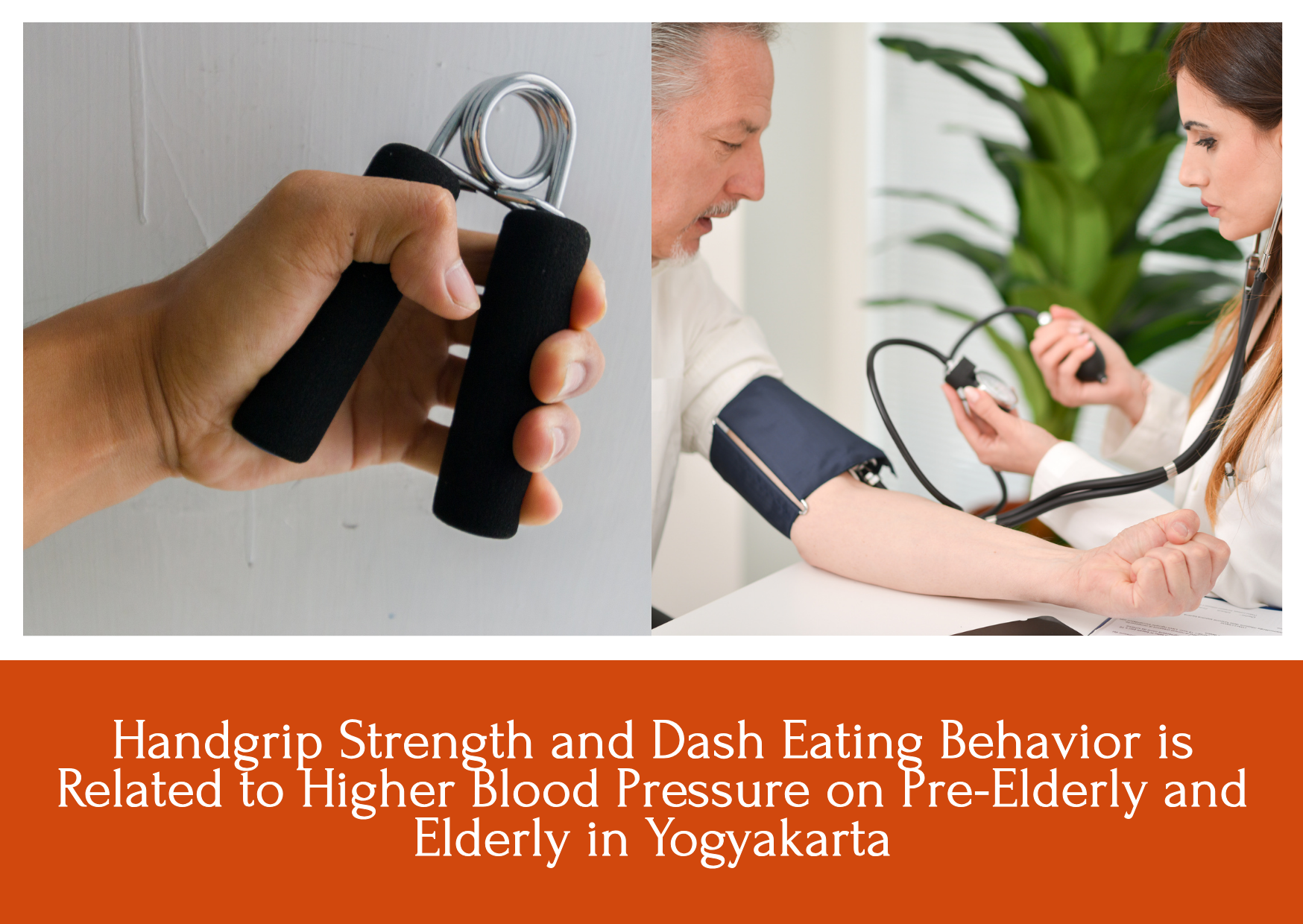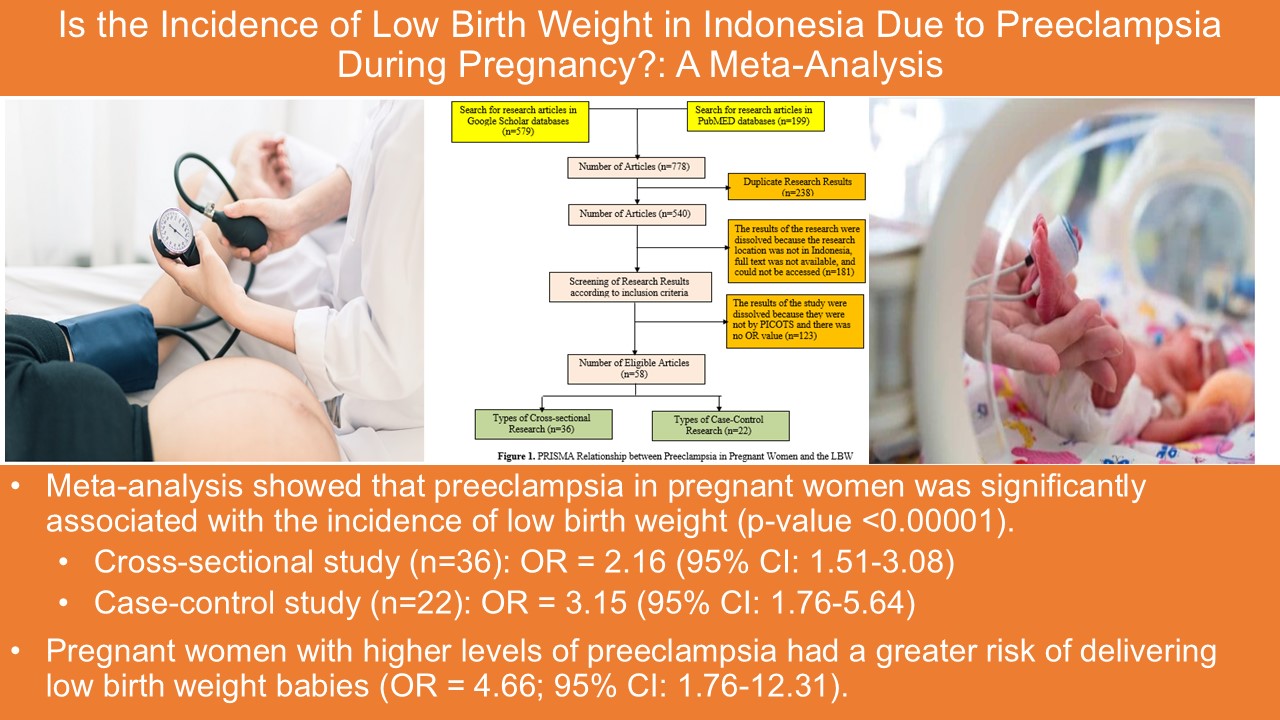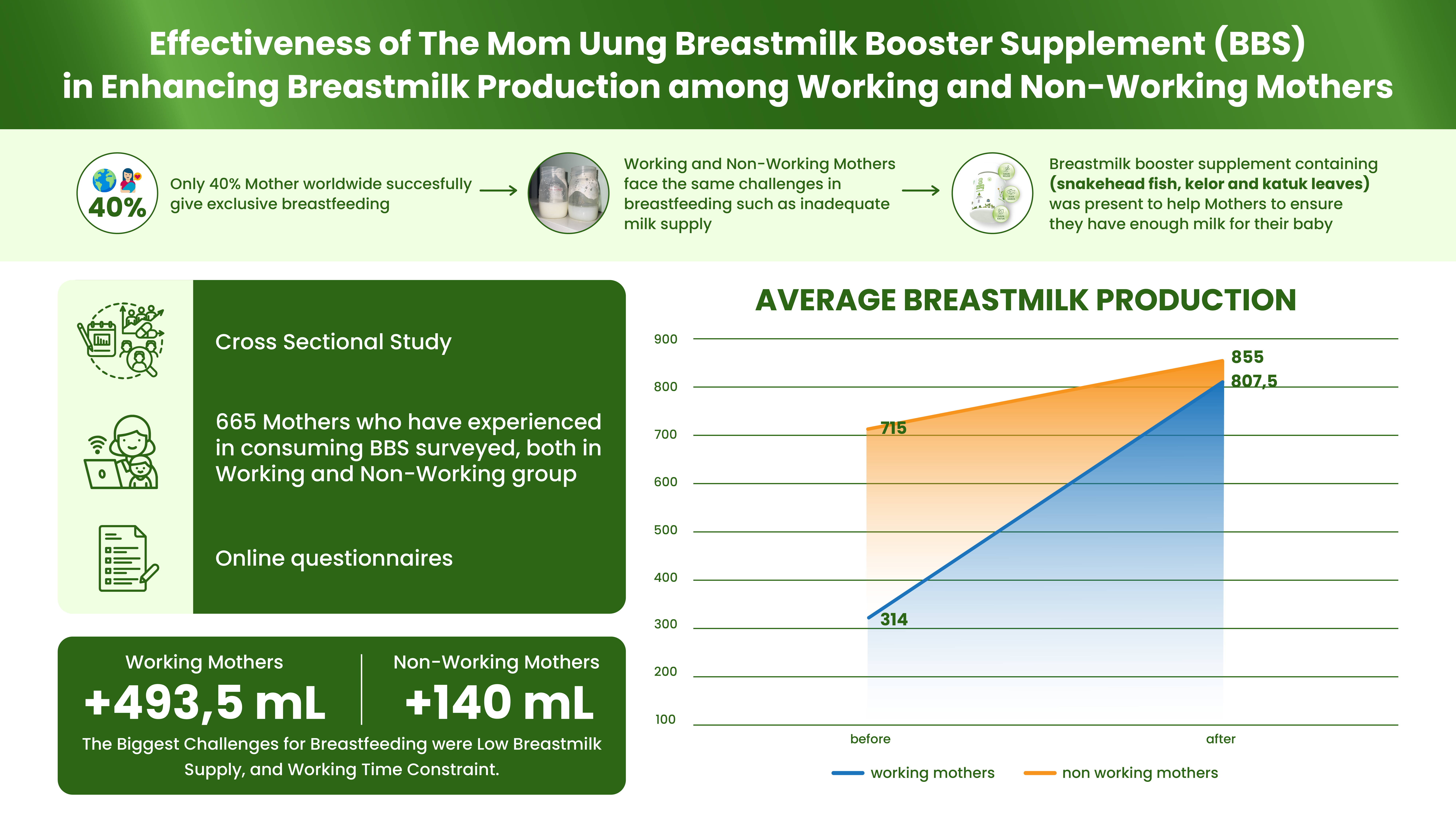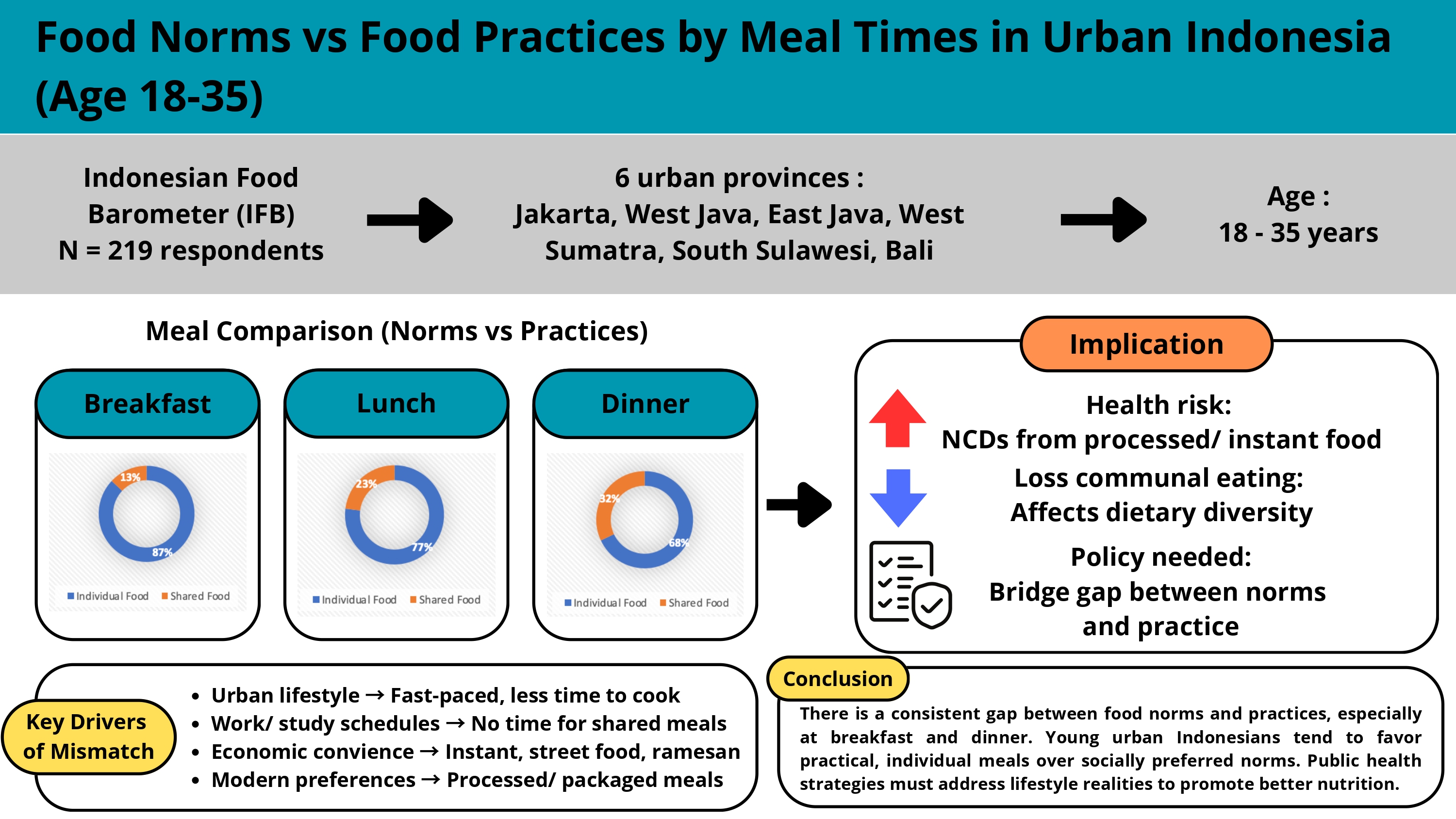HANDGRIP STRENGTH AND DASH EATING BEHAVIOR IS RELATED TO HIGHER BLOOD PRESSURE ON PRE-ELDERLY AND ELDERLY IN YOGYAKARTA

Downloads
Handgrip strength (HGS) reflects muscle health and is linked to hypertension, yet its relationship with blood pressure (BP) in older adults is underexplored. DASH dietary patterns, crucial for BP management, may provide further insights into this connection. This study aims to examine the association between HGS and DASH eating behavior with blood pressure in pre-elderly and elderly populations. A cross-sectional study was conducted on pre-elderly and elderly outpatient at Wirosaban Hospital, Yogyakarta in July to August 2024. HGS was measured using a hand dynamometer, while BP was recorded using a standard sphygmomanometer. Adherence to DASH were measured by 24-hour food recall and then categorized by questionnaire of DASH eating behavior. Data were analyzed by correlation and multiple regression, with α 5%. Hypertension was found in about 68.8% of subjects. Subjects who have lower HGS were about 68.8% and 81.7% of low category of DASH eating behavior. Participants with lower HGS had notably higher systolic and diastolic BP compared to those with higher HGS. Stratification analysis revealed that there were no significant association between HGS and high blood pressure both in elderly and pre-elderly (p 0.063 and p 1.000). In the other hand, low DASH eating behavior was significantly related to higher blood pressure in pre-elderly group (p 0.031). Reduced HGS is likely linked to higher BP in the elderly. Maintaining DASH-like diet adherence and muscle strength may be crucial in mitigating hypertension risk and comorbidity in older adults.
Altawili, A. A., Altawili, M., Alwadai, A. M., Alahmadi, A. S., Alshehri, A. M. A., Muyini, B. H., Alshwwaf, A. R., Almarzooq, A. M., Alqarni, A. H. A., Alruwili, Z. A. L., Alharbi, M. M., Alrashed, Y. M., & Almuhanna, N. M. (2023). An Exploration of Dietary Strategies for Hypertension Management: A Narrative Review. Cureus, 15(12), e50130. https://doi.org/10.7759/cureus.50130
Carey, R. M., Muntner, P., Bosworth, H. B., & Whelton, P. K. (2018). Prevention and Control of Hypertension. Journal of the American College of Cardiology, 72(11), 1278–1293. https://doi.org/10.1016/j.jacc.2018.07.008
Challa, H. J., Ameers, M. A., & Uppaluri, K. R. (2024). DASH Diet to Stop Hypertension. StatPearls [Internet]. Treasure Island (FL): StatPearls Publishing.
Conlin, P. R., Chow, D., Miller, E. R., Svetkey, L. P., Lin, P.-H., Harsha, D. W., Moore, T. J., Sacks, F. M., & Appel, L. J. (2000). The effect of dietary patterns on blood pressure control in hypertensive patients: Results from the dietary approaches to stop hypertension (DASH) trial. American Journal of Hypertension, 13(9), 949–955. https://doi.org/10.1016/S0895-7061(99)00284-8
Cruz-Jentoft, A. J., Bahat, G., Bauer, J., Boirie, Y., Bruyère, O., Cederholm, T., Cooper, C., Landi, F., Rolland, Y., Sayer, A. A., Schneider, S. M., Sieber, C. C., Topinkova, E., Vandewoude, M., Visser, M., Zamboni, M., Bautmans, I., Baeyens, J.-P., Cesari, M., … Schols, J. (2019). Sarcopenia: revised European consensus on definition and diagnosis. Age and Ageing, 48(1), 16–31. https://doi.org/10.1093/ageing/afy169
Departemen Kesehatan RI. (2005). Pedoman Pembinaan Kesehatan Usia Lanjut Bagi Petugas Kesehatan. Departemen Kesehatan RI.
Dewiasty, E., Agustina, R., Saldi, S. R. F., Pramudita, A., Hinssen, F., Kumaheri, M., de Groot, L. C. P. G. M., & Setiati, S. (2022). Malnutrition Prevalence and Nutrient Intakes of Indonesian Community-Dwelling Older Adults: A Systematic Review of Observational Studies. Frontiers in Nutrition, 9. https://doi.org/10.3389/fnut.2022.780003
Feng, Q., Jiang, C., Wang, M., Cai, R., Wang, H., Wu, D., Wang, F., Lin, L., & Nassis, G. P. (2021). Association between relative handgrip strength and hypertension in Chinese adults: An analysis of four successive national surveys with 712,442 individuals (2000-2014). PLoS ONE, 16(10), e0258763. https://doi.org/10.1371/journal.pone.0258763
Fuchs, F. D., & Whelton, P. K. (2020). High Blood Pressure and Cardiovascular Disease. Hypertension,75, 285–292. https://doi.org/10.1161/HYPERTENSIONAHA.119.14240
Gaikwad, R. N., Gupta, S. J., Samarth, A. R., & Sankalecha, T. H. (2016). Handgrip dynamometry: a surrogate marker of malnutrition to predict the prognosis in alcoholic liver disease. Annals of Gastroenterology, 29.1-6. https://doi.org/10.20524/aog.2016.0049
James, P. A., Oparil, S., Carter, B. L., Cushman, W. C., Dennison-Himmelfarb, C., Handler, J., Lackland, D. T., LeFevre, M. L., MacKenzie, T. D., Ogedegbe, O., Smith, S. C., Svetkey, L. P., Taler, S. J., Townsend, R. R., Wright, J. T., Narva, A. S., & Ortiz, E. (2014). 2014 Evidence-Based Guideline for the Management of High Blood Pressure in Adults. JAMA, 311(5), 507. https://doi.org/10.1001/jama.2013.284427
Jang, A., Bae, C. H., Han, S. J., & Bae, H. (2021). Association Between Length of Stay in the Intensive Care Unit and Sarcopenia Among Hemiplegic Stroke Patients. Annals of Rehabilitation Medicine, 45(1), 49–56. https://doi.org/10.5535/arm.20111
Ji, C., Zheng, L., Zhang, R., Wu, Q., & Zhao, Y. (2018). Handgrip strength is positively related to blood pressure and hypertension risk: results from the National Health and nutrition examination survey. Lipids in Health and Disease, 17(1), 86. https://doi.org/10.1186/s12944-018-0734-4
Joyce, B. T., Wu, D., Hou, L., Dai, Q., Castaneda, S. F., Gallo, L. C., Talavera, G. A., Sotres-Alvarez, D., Van Horn, L., Beasley, J. M., Khambaty, T., Elfassy, T., Zeng, D., Mattei, J., Corsino, L., & Daviglus, M. L. (2019). DASH diet and prevalent metabolic syndrome in the Hispanic Community Health Study/Study of Latinos. Preventive Medicine Reports, 15, 100950. https://doi.org/10.1016/j.pmedr.2019.100950
Jung, S. E., Shin, Y. H., Cave, L., Rockett, J., & Hermann, J. (2022). Understanding Whole Grain Consumption among Low-Income Older Adults Using the Theory of Planned Behavior. Journal of Nutrition in Gerontology and Geriatrics, 41(1), 46–64. https://doi.org/10.1080/21551197.2021.2024477
Kawamoto, R., Ninomiya, D., Kasai, Y., Kusunoki, T., Ohtsuka, N., Kumagi, T., & Abe, M. (2016). Handgrip strength is associated with metabolic syndrome among middle-aged and elderly community-dwelling persons. Clinical and Experimental Hypertension, 38(2), 245–251. https://doi.org/10.3109/10641963.2015.1081232
Kementerian Kesehatan RI. (2018). Riset Kesehatan Dasar Tahun 2018. http://labdata.litbang.kemkes.go.id/images/download/laporan/RKD/2018/Laporan_Nasional_RKD2018_FINAL.pdf
Kementerian Kesehatan RI. (2019). Angka Kecukupan Gizi yang dianjurkan Tahun 2019.
Kementerian Kesehatan RI. (2024). Laporan Survey Kesehatan Indonesia Tahun 2023. Kementerian Kesehatan RI.
Larsson, L., Degens, H., Li, M., Salviati, L., Lee, Y. il, Thompson, W., Kirkland, J. L., & Sandri, M. (2019). Sarcopenia: Aging-Related Loss of Muscle Mass and Function. Physiological Reviews, 99(1), 427–511. https://doi.org/10.1152/physrev.00061.2017
Leszczak, J., Czenczek-Lewandowska, E., Asif, M., Baran, J., Mazur, A., & Wyszyńska, J. (2024). Risk factors and prevalence of hypertension in older adults from south-eastern Poland: an observational study. Scientific Reports, 14(1), 1450. https://doi.org/10.1038/s41598-024-52009-3
Park, Y.-M. M., Steck, S. E., Fung, T. T., Zhang, J., Hazlett, L. J., Han, K., Lee, S.-H., Kwon, H.-S., & Merchant, A. T. (2017). Mediterranean diet, Dietary Approaches to Stop Hypertension (DASH) style diet, and metabolic health in U.S. adults. Clinical Nutrition, 36(5), 1301–1309. https://doi.org/10.1016/j.clnu.2016.08.018
Parker, B. A., Smithmyer, S. L., Jarvis, S. S., Ridout, S. J., Pawelczyk, J. A., & Proctor, D. N. (2007). Evidence for reduced sympatholysis in leg resistance vasculature of healthy older women. American Journal of Physiology-Heart and Circulatory Physiology, 292(2), H1148–H1156. https://doi.org/10.1152/ajpheart.00729.2006
Pratt, J., Paolocci, N., Boreham, C., & De Vito, G. (2023). Grip strength positively correlates with blood pressure in individuals with abnormal adiposity. Journal of Human Hypertension, 38(2), 110–119. https://doi.org/10.1038/s41371-023-00862-6
Roberts, H. C., Denison, H. J., Martin, H. J., Patel, H. P., Syddall, H., Cooper, C., & Sayer, A. A. (2011). A review of the measurement of grip strength in clinical and epidemiological studies: towards a standardised approach. Age and Ageing, 40(4), 423–429. https://doi.org/10.1093/ageing/afr051
Unger, T., Borghi, C., Charchar, F., Khan, N. A., Poulter, N. R., Prabhakaran, D., Ramirez, A., Schlaich, M., Stergiou, G. S., Tomaszewski, M., Wainford, R. D., Williams, B., & Schutte, A. E. (2020). 2020 International Society of Hypertension Global Hypertension Practice Guidelines. Hypertension, 75(6), 1334–1357. https://doi.org/10.1161/HYPERTENSIONAHA.120.15026
Veralia, V., Malini, H., & Gusty, R. P. (2023). Effect of isometric handgrip exercise on blood pressure and comfort among hypertensive patients. Jurnal Ners, 18(1), 25–30. https://doi.org/10.20473/jn.v18i1.40942
Wang, Y., & Xu, D. (2017). Effects of aerobic exercise on lipids and lipoproteins. Lipids in Health and Disease, 16(1), 132. https://doi.org/10.1186/s12944-017-0515-5
WHO. (2023). Hypertension. https://www.who.int/news-room/fact-sheets/detail/hypertension
Wiśniowska-Szurlej, A., Ćwirlej-Sozańska, A., Wołoszyn, N., Sozański, B., & Wilmowska-Pietruszyńska, A. (2019). Association between Handgrip Strength, Mobility, Leg Strength, Flexibility, and Postural Balance in Older Adults under Long-Term Care Facilities. BioMed Research International, 2019, 1–9. https://doi.org/10.1155/2019/1042834
Wolfe, R. R. (2006). The underappreciated role of muscle in health and disease. The American Journal of Clinical Nutrition, 84(3), 475–482. https://doi.org/10.1093/ajcn/84.3.475
Zhang, Xiaoxia., Huang, Lingling., Peng, Xin., Xie, Yixian., Bao, Xinyu., Huang, Junxuan., & Wang, Peixi. (2020). Association of handgrip strength with hypertension among middle-aged and elderly people in Southern China: A cross-sectional study. Clinical and Experimental Hypertension, 42(2), 190–196. https://doi.org/10.1080/10641963.2019.1601206
Zhou, B., Carrillo-Larco, R. M., Danaei, G., Riley, L. M., Paciorek, C. J., Stevens, G. A., Gregg, E. W., Bennett, J. E., Solomon, B., Singleton, R. K., Sophiea, M. K., Iurilli, M. L., Lhoste, V. P., Cowan, M. J., Savin, S., Woodward, M., Balanova, Y., Cifkova, R., Damasceno, A., … Ezzati, M. (2021). Worldwide trends in hypertension prevalence and progress in treatment and control from 1990 to 2019: a pooled analysis of 1201 population-representative studies with 104 million participants. The Lancet, 398(10304), 957–980. https://doi.org/10.1016/S0140-6736(21)01330-1

This work is licensed under a Creative Commons Attribution-NonCommercial-ShareAlike 4.0 International License.
- MEDIA GIZI INDONESIA Journal is the copyright owner of all materials published on this website.
- The formal legal provisions for access to digital articles of this electronic journal are subject to the terms of the Creative Commons Attribution-NonCommercial-ShareAlike license (CC BY-NC-SA 4.0), which means that MEDIA GIZI INDONESIA Journal and readers reserve the right to save, transmit media / format, manage in database, maintain, and publish articles as long as it continues to include the name of the Author.
- Printed and published print and electronic manuscripts are open access for educational, research and library purposes. In addition to these objectives, the editorial board shall not be liable for violations of copyright law.


2.png)





















